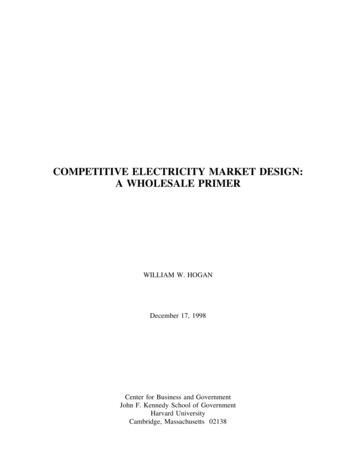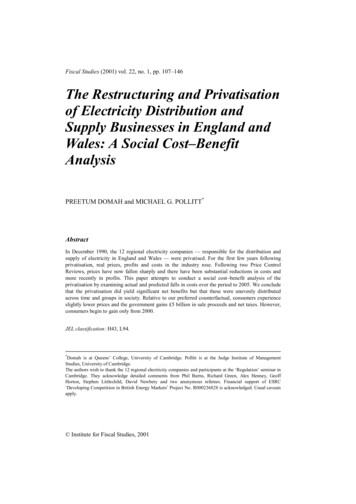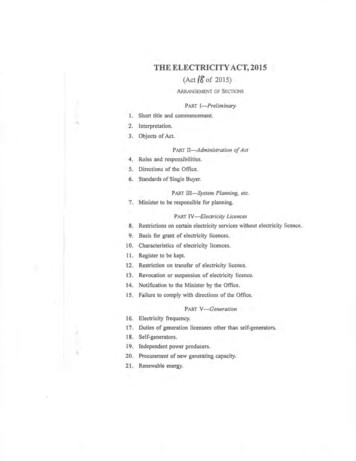
Transcription
COMPETITIVE ELECTRICITY MARKET DESIGN:A WHOLESALE PRIMERWILLIAM W. HOGANDecember 17, 1998Center for Business and GovernmentJohn F. Kennedy School of GovernmentHarvard UniversityCambridge, Massachusetts 02138
CONTENTSINTRODUCTION . . . . . . . . . . . . . . . . . . . . . . . . . . . . . . . . . . . . . . . . . . . . . . . . . .ECONOMICS OF A COMPETITIVE ELECTRICITY MARKETShort-Run Market. . . . . . . . . . . . . . . . . . . . . . . . . . .Transmission Congestion. . . . . . . . . . . . . . . . . . . . . . .Long-Run Market Contracts. . . . . . . . . . . . . . . . . . . .Equivalent Transmission Interpretations. . . . . . . . . . .Scheduling and Balancing. . . . . . . . . . . . . . . . . . . . . .Long-Term Market Investment. . . . . . . . . . . . . . . . . .Access Fees For Embedded Cost Recovery. . . . . . . . . .Security Concerns and Capacity Reserves. . . . . . . . . .123581417192021CONCLUSION . . . . . . . . . . . . . . . . . . . . . . . . . . . . . . . . . . . . . . . . . . . . . . . . . . . . 22APPENDIXCompetitive Electricity Market Pricing . . . . . . . . . . . . . . . . . . . . . . . . . . . . . . . . . . 23INTRODUCTION . . . . . . . . . . . . . . . . . . . . . . . . . . . . . . . . . . . . . . . . . . . . . . . . . . 23SHORT-RUN TRANSMISSION PRICINGTransmission Pricing Examples .400 MW . . . . . . . . . .300 MW . . . . . . . . . .200 MW . . . . . . . . . .100 MW . . . . . . . . . .Implications . . . . . . . . . . . . . . . .23242627272829CONTRACT NETWORK EXAMPLES . . . . . . . .Economic Dispatch on a Grid . . . . . . . .Transmission Constraints . . . . . . . . . . .Zonal Versus Nodal Pricing ApproachesTransmission Congestion Contracts . . .3039424852
COMPETITIVE ELECTRICITY MARKETS:A WHOLESALE PRIMER1William W. Hogan2A short-term electricity market coordinated by a system operator providesa foundation for a competitive electricity market. Combined with long-termcontracts for generation and transmission congestion, the spot-market andcompetitive market pricing can support open access to the transmission grid.INTRODUCTIONElectricity market restructuring emphasizes the potential for competition ingeneration and retail services, with operation of transmission and distribution wires as amonopoly. Network interactions complicate the design of the institutions and pricingarrangements for open access to the wires. The design of the institutions for thewholesale market can accommodate access for both wholesale and retail competitionwhile recognizing the special requirements of reliability in the transmission grid.A pool-based, short-term electricity market coordinated by a system operatorprovides a foundation for building an open access system. Coordination through thesystem operator is unavoidable, and a bid-based spot-market built on the principles ofeconomic dispatch creates the setting in the wholesale market for competition among themarket participants. The associated locational prices define the opportunity costs oftransmission usage and support transmission rights without restricting the actual use ofthe system. A system of contracts can provide the connection between short-termoperations and long-term investment built on market incentives.The key elements of the wholesale market design include: A short-term spot market with bid-based security-constrained economic dispatchcoordinated by the system operator. Spot-market transactions at market clearing locational prices to include marginal1This paper combines and updates introductory descriptions from previous papers by the author oncompetitive market design and transmission pricing.2Lucius N. Littauer Professor of Public Policy and Administration, John F. Kennedy School ofGovernment, Harvard University, and Senior Advisor, Putnam, Hayes & Bartlett, Inc. This paper draws on workfor the Harvard Electricity Policy Group and the Harvard-Japan Project on Energy and the Environment. The authoris or has been a consultant on electric market reform and transmission issues for British National Grid Company,GPU Inc. (and the Supporting Companies of PJM), GPU PowerNet Pty Ltd, Duquesne Light Company, ElectricityCorporation of New Zealand, National Independent Energy Producers, New York Power Pool, New York UtilitiesCollaborative, Niagara Mohawk Corporation, PJM Office of Interconnection, San Diego Gas & Electric Corporation,Transpower of New Zealand, Westbrook Power, Williams Energy Group, and Wisconsin Electric Power Company.The views presented here are not necessarily attributable to any of those mentioned, and any remaining errors aresolely the responsibility of the author. (http://ksgwww.harvard.edu/people/whogan).
2losses and congestion. Bilateral transactions with short-term transmission usage charges equal to thedifference in the locational prices at source and destination. A two settlement system using day-ahead bidding, pricing and contracts, withreal-time balancing at the real-time market prices. Transmission congestion contracts to allocate the benefits of transmission rights. Network access charges to cover the embedded costs of the grid and other fixedcharges. Usage charges for loads to recover other unbundled ancillary service costs.A sketch of the details outlines the basic elements of the competitive market designthat would support both wholesale and retail transactions.ECONOMICS OF A COMPETITIVE ELECTRICITY MARKETA general framework that encompasses the essential economics of electricitymarkets provides a point of reference for evaluating market design elements. Thisframework for wholesale market provides the foundation for pricing and access, as wellas extension to retail ationRestructuringCompetitive Wholesale Electricity Market Structureof electricity markets typicallyemphasizes functional unbundlingGencoGencoGencoGencoGencoGencoof the verticallyintegrated system.The usual separaPoolcotion into generation,GridcoGridcotransmission, andSystem Operatordistribution is insufficient. In an electricity market, theDiscoDiscoDiscoDiscoDiscoDiscotransmission wiresand the pool disCust.Cust.Cust.Cust.Cust.Cust.patch are distinctessential facilities.The special conditions in the electricity system stand as barriers to an efficient, large-scale market inelectricity. A pool-based market coordinated by a system operator helps overcome thesebarriers.Regulated
3Reliable operation is a central requirement and constraint for any electricity system.Given the strong and complex interactions in electric networks, current technology witha free-flowing transmission grid dictates the need for a system operator that coordinatesuse of the transmission system. Control of transmission usage means control of dispatch,which is the principal or only means of adjusting the use of the network. Hence, openaccess to the transmission grid means open access to the dispatch as well. There mustbe a system operator coordinating use of the transmission system. That this systemoperator should also be independent of the existing electric utilities and other marketparticipants is attractive in its simplicity in achieving equal treatment of all marketparticipants. The independent system operator provides an essential service, but does notbe compete in the energy market. In the analysis of electricity markets, therefore, a keyfocus is the design of the interaction between transmission and dispatch, both proceduresand pricing, to support a competitive market.To provide an overview of the operation of an efficient, competitive wholesaleelectricity market, it is natural to distinguish between the short-run operations coordinatedby the system operator and long-run decisions that include investment and contracting.Under the competitive market assumption, market participants are price takers and includethe generators and eligible customers. For this discussion, distributors are included ascustomers in the wholesale market, operating at arm's length from generators. The systemis much simpler in the very short run when it is possible to give meaningful definitionto concepts such as opportunity cost. Once the short-run economics are established, thelong-run requirements become more transparent. Close attention to the connectionbetween short- and long-run decisions isolates the special features of the electricitymarket.Short-Run Market.The short run is a long time on the electrical scale, but short on human scale – say,half an hour. The short-run market is relatively simple. In the short run, locationalinvestment decisions have been made. Power plants, the transmission grid, anddistribution lines are all in place. Customers and generators are connected and the workof buyers, sellers, brokers and other service entities is largely complete. The onlydecisions that remain are for delivery of power, which in the short-run is truly acommodity product.33On the electrical scale, much can happen in half an hour and the services provided by the systeminclude many details of dynamic frequency control and emergency response to contingencies. Due to transactioncosts, if nothing else, it would be inefficient to unbundle all of these services, and many are covered as average costsin the overhead of the system. How far unbundling should go is an empirical question. For example, real powershould be identified and its marginal cost recognized, but should this extend to reactive power and voltage controlas well? Or to spinning reserve required for emergency supplies? The costs associated with delivery of electricenergy include many services. The direct fuel cost of generation is only one component. In analyses of energypricing, there is no uniformity in the treatment of these other, ancillary services. The typical approach formulatesan explicit model approximating the full electricity system, computing both a dispatch solution and associated prices
4Over the half hour, the market operates competitively to move real power fromgenerators to customers. Generators have a marginal cost of generating real power fromeach plant, and customers have different quantities of demand depending on the price atthat half hour. The collection of generator costs stacks up to define the generation "meritorder," from least to most expensive. This merit order defines the short-run marginal-costcurve, which governs power supply. Similarly, customers have demands that are sensitiveto price, and higher prices produce lower demands. Market participants using bilateraltransactions provide schedules with any associated bids. Generators and customers donot act unilaterally; they provide information to the dispatcher to be used in a decisionprocess that will determine which plants will run at any given half hour. Power poolsprovide the model for achieving the most efficient dispatch given the short-run marginalcosts of power supply. Although dispatchable demand is not always included, there isnothing conceptually or technically difficult about this extension. The system operatorcontrols operation of the system to achieve the efficient match of supply and demandbased on the preferences of the participants as expressed in the bids.This efficientcentral dispatch canShort-Run Electricity Marketbe made compatibleShort-RunEnergy Pricewith the marketMarginal( /mwH)Costoutcome.ThePrice at7-7:30 p.m.fundamental principle is that for thesame load, theDemandleast-cost dispatch7-7:30 p.m.and the competiPrice at9-9:30 a.m.tive-market dispatchare the same. ThePrice atDemandprincipal difference2-2:30 a.m.9-9:30 a.m.between the tradiDemandtional power pool2-2:30 a.m.and the marketQ2QmaxQ1MWsolution is the pricecharged to thecustomer. In the traditional power pool model, customers pay and generators receiveaverage cost, at least on average. However, as shown in the figure marginal costfor the explicit variables. Everything that is not explicit is treated as an ancillary service, for which the assumptionmust be that the services will be provided and charged for in some way other than through the explicit prices in themodel. Given the complexity of the real electric system, such approximations or simplifications are found in everymodel, and there is always a boundary between the explicit variables modeled and the implicit variables that willbe treated as separate ancillary services. Payment for the ancillary services may be through an average cost upliftapplied to all loads. Development of a full description of the interactions with ancillary services is beyond the scopeof the present discussion. For the sake of the present discussion, focus on real power and assume that furtherunbundling would go beyond the point of diminishing returns in the short-run market.
5implicitly determines the least-cost dispatch, and marginal cost is the standard determinantof competitive market pricing.An important distinction between the traditional central dispatch and thedecentralized market view is found in the source of the marginal-cost information for thegenerator supply curve. Typically, the cost data come from engineering estimates of theenergy cost of generating power from a given plant at a given time. However, relyingon these engineering estimates is problematic in the market model since the trueopportunity costs may include other features, such as the different levels of maintenance,that would not be captured in the fuel cost. Replacement of the generator’s engineeringestimates (that report only incremental fuel cost) with the generator’s market bids is thenatural alternative. Each bid defines the minimum acceptable price that the generatorwould accept to run the plant in the given half hour. And these bids serve as the guidefor the dispatch.As long as the generator receives the market clearing price, and there are enoughcompetitors so that each generator assumes that it will not be determining the marginalplant, then the optimal bid for each generator is the true marginal cost: To bid morewould only lessen the chance of being dispatched, but not change the price received. Tobid less would create the risk of running and being paid less than the cost of generationfor that plant. Hence, with enough competitors and no collusion, the short-run centraldispatch market model can elicit bids from buyers and sellers. The system operator cantreat these bids as the supply and demand and determine the balance that maximizesbenefits for producers and consumers at the market equilibrium price. Hence, in the shortrun electricity is a commodity, freely flowing into the transmission grid from selectedgenerators and out of the grid to the willing customers. Every half hour, customers payand generators receive the short-run marginal-cost price for the total quantity of energysupplied in that half hour. Everyone pays or receives the true opportunity cost in theshort run. Payments follow in a simple settlement process.Transmission Congestion.This overview of the short-run market model is by now familiar and found inoperation in many countries. However, this introductory overview conceals a criticaldetail that would be relevant for transmission pricing. Not all power is generated andconsumed at the same location. In reality, generating plants and customers are connectedthrough a free-flowing grid of transmission and distribution lines.In the short-run, transmission too is relatively simple. The grid has been built andeveryone is connected with no more than certain engineering requirements to meetminimum technical standards. In this short-run world, transmission reduces to nothingmore than putting power into one part of the grid and taking it out at another. Powerflow is determined by physical laws, but a focus on the flows – whether on a fictionalcontract path or on more elaborate allocation methods – is a distraction. The simplermodel of input somewhere and output somewhere else captures the necessary reality. In
6this simple model, transmission complicates the short-run market through the introductionof losses and possible congestion costs.Transmission of power over wires encounters resistance, and resistance createslosses. Hence the marginal cost of delivering power to different locations differs at leastby the marginal effect on losses in the system. Incorporating these losses does not requirea major change in the theory or practice of competitive market implementation.Economic dispatch would take account of losses, and the market equilibrium price couldbe adjusted accordingly. Technically this would yield different marginal costs anddifferent prices, depending on location, but the basic market model and its operation inthe short-run would be preserved.Transmission congestion has a related effect. Limitations in the transmission gridin the short run may constrain long-distance movement of power and thereby impose ahigher marginal cost in certain locations. In the simplest case, power will flow over thetransmission line from the low cost to the high cost location. If this line has a limit, thenin periods of high demand not all the power that could be generated in the low costregion could be used, and some of the cheap plants would be "constrained off." In thiscase, the demand would be met by higher cost plants that, absent the constraint, wouldnot run, but due to transmission congestion would be then "constrained on." Themarginal cost in the two locations differs because of transmission congestion. Themarginal cost of power at the low cost location is no greater than the cost of the cheapestconstrained-off plant at that location; otherwise the plant would run. Similarly, themarginal cost at the high cost location is no less than the cost of the most expensiveconstrained-on plant at that location; otherwise the plant would not be in use. Thedifference between these two costs, net of marginal losses, is the congestion rental.4This congested-induced marginal-cost difference can be as large as the cost of thegeneration in the unconstrained case. If a cheap coal plant is constrained off and an oilplant, which costs more than twice as much to run, is constrained on, the difference inmarginal costs by region is greater than the cost of energy at the coal plant. This resultdoes not depend in any way on the use of a simple case with a single line and twolocations. In a real network, the interactions are more complicated – with loop flow andmultiple contingencies confronting thermal limits on lines or voltage limits on buses – butthe result is the same. It is easy to construct examples where congestion in thetransmission grid leads to marginal costs that differ by more than 100% across differentlocations.If there is transmission congestion, therefore, the short-run market model anddetermination of marginal costs must include the effects of the constraints. This extensionpresents no difficulty in principle. The only impact is that the market now includes a set4Losses are not always negligible and could be treated explicitly. However, it would add nothing to thediscussion here. At locations distant from the constrained off or constrained on plants, prices can vary even moreas it may be necessary to increase the use of expensive plants and decrease the use of cheap plants in combinationsthat create opportunity costs greater than the cost of any single plant.
7of prices, one for each location. Economic dispatch would still be the least-costequilibrium. Generators would still bid as before, with the bid understood to be theminimum acceptable price at their location. Customers would bid also, with dispatchabledemand and the bid setting the maximum price that would be paid at the customer’slocation. The economic dispatch process would produce the corresponding prices at eachlocation, incorporating the combined effect of generation, losses and congestion. In termsof their own supply and demand, everyone would see a single price, which is thelocational marginal cost based price of power at their location. If a transmission priceis necessary, the natural definition of transmission is supplying power at one location andusing it at another. The corresponding transmission price would be the differencebetween the prices at the two locations.This same framework lends itself easily to extensions including bilateraltransactions. If market participants wish to schedule transmission between two locations,the opportunity cost of the transmission is just this transmission price of the differencebetween spot prices at the two locations. This short-run transmission usage pricing,therefore, is efficient and non-discriminatory. In addition, the same principles could applyin a multi-settlement framework, with day-ahead scheduling and real-time dispatch.These extensions could be important in practice, but would not fundamentally change theoutline of the structure of electricity markets.This short-run competitive market with bidding and centralized dispatch isconsistent with economic dispatch. The locational prices define the true and fullopportunity cost in the short run. Each generator and each customer sees a single pricefor the half hour, and the prices vary over half hours to reflect changing supply anddemand conditions. All the complexities of the power supply grid and networkinteractions are subsumed under the economic dispatch and calculation of the locationalprices. These are the only prices needed, and payments for short-term energy are the onlypayments operating in the short run, with administrative overhead covered by rents onlosses or, if necessary, a small markup added to the cost of ancillary services and appliedto all load. The system operator coordinates the dispatch and provides the informationfor settlement payments, with regulatory oversight to guarantee comparable servicethrough open access to the pool run by the system operator through a bid-based economicdispatch.With efficient pricing, users have the incentive to respond to the requirements ofreliable operation. Absent such price incentives, the system operator would be requiredto restrict choice and limit the market, in order to give the system operator enough controlto counteract the perverse incentives that would be created by prices that did not reflectthe marginal costs of dispatch. A competitive market with choice and customer flexibility
8depends on getting the usage pricing right.Long-Run Market Contracts.With changing supply and demand conditions, generators and customers will seefluctuations in short-run prices. When demand is high, more expensive generation willbe employed, raising the equilibrium market prices. When transmission constraints bind,congestion costs will change prices at different locations.Even without transmission congestion constraints, the spot market price can bevolatile. This volatility in prices presents its own risks for both generators and customers,and there will be a natural interest in long-term mechanisms to mitigate or share this risk.The choice in a market is for long-term contracts.Traditionally, and in many other markets, the notion of a long-term contract carrieswith it the assumption that customers and generators can make an agreement to trade acertain amount of power at a certain price. The implicit assumption is that a specificgenerator will run to satisfy the demand of a specific customer. To the extent that thecustomer’s needs change, the customer might sell the contract in a secondary market, andso too for the generator. Efficient operation of the secondary market would guaranteeequilibrium and everyone would face the true opportunity cost at the margin.However, this notion of specific performance stands at odds with the operation ofthe short-run market for electricity. To achieve an efficient economic dispatch in theshort-run, the dispatcher must have freedom in responding to the bids to decide whichplants run and which are idle, independent of the provisions of long-term contracts. Andwith the complex network interactions, it is impossible to identify which generator isserving which customer. All generation is providing power into the grid, and allcustomers are taking power out of the grid. It is not even in the interest of the generatorsor the customers to restrict their dispatch and forego the benefits of the most economicuse of the available generation. The short-term dispatch decisions by the system operatorare made independent of and without any recognition of any long-term contracts. In thisway, electricity is not like other commodities.This dictate of the physical laws governing power flow on the transmission griddoes not preclude long-term contracts, but it does change the essential character of thecontracts. Rather than controlling the dispatch and the short-run market, long-termcontracts would focus on the problem of price volatility and provide a price hedge not bymanaging the flow of power but by managing the flow of money. The short-run pricesprovide the right incentives for generation and consumption, but create a need to hedgethe price changes. Recognizing the operation of the short-run market, there is aneconomic equivalent of the long-run contract for power that does not require any specificplant to run for any specific customer.Consider the case first of no transmission congestion. In this circumstance, exceptfor the small effect of losses, it is possible to treat all production and consumption as atthe same location. Here the natural arrangement is to contract for the deviation from the
9equilibrium price in the market. A customer and a generator agree on an average pricefor a fixed quantity, say 100 MW at five cents. On the half hour, if the pool price is sixcents, the customer buys power from the pool at six cents and the generators sells powerfor six cents. Under the contract, the generator owes the customer one cent for each ofthe 100 MW over the half hour. In the reverse case, with the pool price at three cents,the customer pays three cents to the system operator, which in turn pays three cents tothe generator, but now the customer owes the generator two cents for each of the 100MW over the half hour. Familiar in other commodity industries, this is known in theelectricity market as a "contract for differences."In effect, the generator and the customer have a long-term contract for 100 MWat five cents. The contract requires no direct interaction with system operator other thanfor the continuing short-run market transactions. But through the interaction with systemoperator, the situation is even better than with a long-run contract between a specificgenerator and a specific customer. For now if the customer demand is above or below100 MW, there is a ready and an automatic secondary market, namely the pool, whereextra power is purchased or sold at the pool price. Similarly for the generator, there isan automatic market for surplus power or backup supplies without the cost and problemsof a large number of repeated short-run bilateral negotiations with other generators. Andif the customer really consumes 100 MW, and the generator really produces the 100 MW,the economics guarantee that the average price is still five cents. Furthermore, with thecontract fixed at 100 MW, rather than the amount actually produced or consumed, thelong-run average price is guaranteed without disturbing any of the short-run incentivesat the margin. Hence the long-run contract is compatible with the short-run market.The price of the generation contract would depend on the agreed reference priceand other terms and conditions. Generators and customers might agree on dead zones,different up-side and down-side price commitments, or anything else that could benegotiated in a free market to reflect the circumstances and risk preferences of the parties.Whether generators pay customers, or the reverse, depends on the terms. However,system operator need take no notice of the contracts, and have no knowledge of the terms.Such contracts for differences have become common in restructured electricity markets.In the presence of transmission congestion, the generation contract is necessary butnot sufficient to provide the necessary long-term price hedge. A bilateral arrangementbetween a customer and a generator can capture the effect of aggregate movements in themarket, when the single market price is up or the single market price is down. However,transmission congestion can produce significant movements in price that are differentdepending on location. If the customer is located far from the generator, transmissioncongestion might confront the customer with a high locational price and leave thegenerator with a low locational price. Now the generator alone cannot provide the naturalback-to-back hedge on fluctuations of the short-run market price. Something more isneeded.Transmission congestion in the short-run market raises another related andsignificant matter for the system operator. In the presence of congestion, revenues
10collected from customers will substantially exceed the payments to generators. Thedifference is the congestion rent that accrues because of constraints in the transmissiongrid. At a minimum, this congestion rent revenue itself will be a highly volatile sourceof payment to the system operator. At worse, if the system operator keeps the congestionrevenue, incentives arise to manipulate dispatch and prevent grid expansion in order togenerate even greater congestion rentals. System operation is a natural monopoly and theoperator could distort
tion into generation, transmission, and distribution is insuf-ficient. In an elec-tricity market, the transmission wires and the pool dis-patch are distinct essential facilities. The special condi-tions in the electricity system stand as barriers to an effic


![05[2] Strategy competitors, competitive rivalry .](/img/2/052-strategy-competitors-competitive-rivalry-competitive-behavior-and-competitive-dynamics.jpg)







